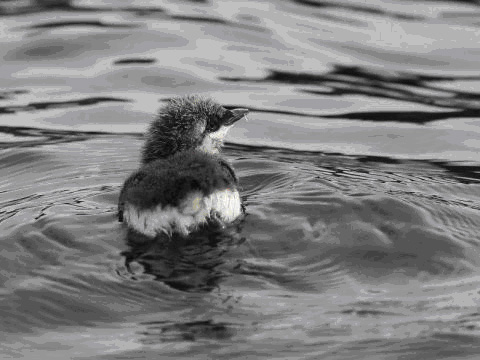
All photos for this article taken by Ron LeValley
www.LeValleyPhoto.com
The Common Murre nest on an island off the Mendocino Headlands and last year prospected among the Brandtís Cormorant colony on Gualala Point Island for nesting sites. This activity illustrates their recovery in California from past human impacts and the expansion of the breeding population in southern Mendocino County. The uninitiated might easily mistake this bird for a penguin, with its white belly, dark head, upright posture and short wings, perfect for diving and flying underwater. This medium sea bird with brown-black upper parts, throat, white under parts, and long, dark bill, and short tail spends 8-9 months a year continuously at sea. Outside the breeding season, the chin and lower half of the face are white with a black line descending from the back of the eye through the white area. They dive to an impressive 240 feet to feed on fish and invertebrates.
They range from coastal islands and headlands in California to Alaska and breed along the Arctic and sub-arctic coasts south to Central California and east to the Gulf of St. Lawrence preferring rocky coasts like ours. Common Murres winter south to southern California and Massachusetts, and in Eurasia. They forage closer to rocky shores during the breeding season but further offshore during non-breeding time.
The short wings that serve them well underwater give their flight a labored look. Although silent on the ocean, they emit a soft murr sound in flight.
They eat polar cod, capelin, sprat, sand eels, small Atlantic cod, and herring, also marine worms, amphipods, shrimp and mollusks. They forage by diving from the surface, and can remain underwater for a minute.
Colonies exhibit densely packed nests of 28-34 birds per square meter. Incubating adults actually touch their neighbors on both sides. They first breed at 4-5 years, laying one white, green, blue or brown egg directly on a rock or a rock shelf with no nesting material added. Both sexes incubate the egg for 4 to 5 weeks and feed the newly hatched chick. At two to three weeks after hatching, before it is able to fly, the chick leaves the colony with one of its parents and moves into the water. A murre chick leaves the cliff in dramatic style. Even without proper flight feathers, it hurls itself off the edge and glides down to sea. The male feeds and cares for the chick until it can fly.
†††††††††

An attempt is underway to reestablish a colony of murres on a small stack called Devilís Slide Rock, on the San Mateo coast near Pacifica. The breeding colony held close to 3,000 murres in early 1980ís but died out from human causes. Tens of thousands of murres in Central California drowned in gill nets between the mid 1970s and mid 1980s. Then in the winter of 1986 the oil barge, Apex Houston, accidentally discharged 26,000 gallons of oil while en route from San Francisco to Long Beach Harbor. About 9,900 sea birds died from the spill, including 6,300 murres. After the spill, no murres bred on Devilís Slide Rock and the colony disappeared. In the spring of 1996, six pairs of murres raised three chicks, the first breeding in ten years on Devilís Slide Rock and that expanded to 190 breeding pairs in 2004.
The expansion of the breeding range of this Chaplinesque bird is a drop of good news in an ocean of bad. If it includes Gualala Point Island, we are all that much richer.

Back to ... Mendocino Coast Audubon Society Newsletter Articles | Home page